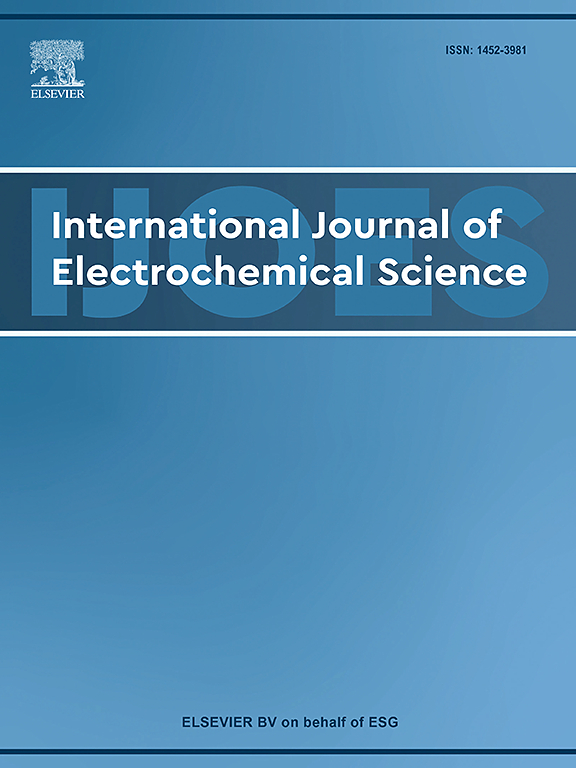In situ FT-IR spectroelectrochemical investigation of the electrochemical reduction of duroquinone
IF 2.4
4区 化学
Q4 ELECTROCHEMISTRY
International Journal of Electrochemical Science
Pub Date : 2025-09-18
DOI:10.1016/j.ijoes.2025.101187
引用次数: 0
Abstract
Quinone is a bioactive compound present in some traditional Chinese medicines and participates in numerous biological processes. The carbonyl group in quinone serves as the active center in electrochemical reactions, functioning as an excellent carrier of electron transfer. In this study, in situ Fourier transform infrared (FT-IR) spectroelectrochemistry enables the real-time tracking of three-dimensional (3D) information at molecular level of different substances throughout the electrochemical process. The detection of absorption peaks corresponding to dimerization and hydrogen bonding in the Fourier transform infrared 3D spectra proves that the electrochemical reduction of duroquinone (DQ) in anhydrous acetonitrile involves dimer formation and development of intramolecular hydrogen bonds within monovalent anion radicals. Consistent with these findings, cyclic voltammetry reveals two pairs of redox peaks and one irreversible anodic peak. Surprisingly, ionic liquids with complex structures of ions, such as 1-butyl-3-methylimidazolium tetrafluoroborate (BMIMBF4) and 1-butyl-3-methylimidazolium hexafluorophosphate (BMIMPF6), make the reduction simpler. Conversely, the transformation of DQ to DQ•- and subsequently to DQ2- without dimer or hydrogen bond occurring, as clearly observed in the infrared cyclic voltabsorptometry (CVA) and derivative cyclic voltabsorptometry (DCVA). DQ undergoes a straightforward, sequential two-step, one-electron transfer process facilitated by the unique composition of ionic liquids, potentially prompting further evaluation of the roles of cations and anions in ionic liquids.
杜醌电化学还原的原位红外光谱电化学研究
醌是一种生物活性化合物,存在于一些中药中,参与许多生物过程。醌中的羰基是电化学反应的活性中心,是电子转移的优良载体。在本研究中,原位傅里叶变换红外(FT-IR)光谱电化学能够在整个电化学过程中实时跟踪不同物质的分子水平的三维(3D)信息。傅里叶变换红外三维光谱中二聚和氢键对应的吸收峰的检测证明,在无水乙腈中,duroquinone (DQ)的电化学还原涉及到二聚体的形成和单价阴离子自由基内分子内氢键的形成。与这些发现一致,循环伏安法显示了两对氧化还原峰和一个不可逆阳极峰。令人惊讶的是,具有复杂离子结构的离子液体,如1-丁基-3-甲基咪唑四氟硼酸盐(BMIMBF4)和1-丁基-3-甲基咪唑六氟磷酸盐(BMIMPF6),使还原过程更简单。相反,DQ到DQ•-和随后到DQ2-的转变没有发生二聚体或氢键,正如在红外循环伏安吸收法(CVA)和衍生循环伏安吸收法(DCVA)中清楚观察到的那样。由于离子液体的独特组成,DQ经历了一个简单、连续的两步、单电子转移过程,这可能促使人们进一步评估阳离子和阴离子在离子液体中的作用。
本文章由计算机程序翻译,如有差异,请以英文原文为准。
求助全文
约1分钟内获得全文
求助全文
来源期刊
CiteScore
3.00
自引率
20.00%
发文量
714
审稿时长
2.6 months
期刊介绍:
International Journal of Electrochemical Science is a peer-reviewed, open access journal that publishes original research articles, short communications as well as review articles in all areas of electrochemistry: Scope - Theoretical and Computational Electrochemistry - Processes on Electrodes - Electroanalytical Chemistry and Sensor Science - Corrosion - Electrochemical Energy Conversion and Storage - Electrochemical Engineering - Coatings - Electrochemical Synthesis - Bioelectrochemistry - Molecular Electrochemistry

 求助内容:
求助内容: 应助结果提醒方式:
应助结果提醒方式:


